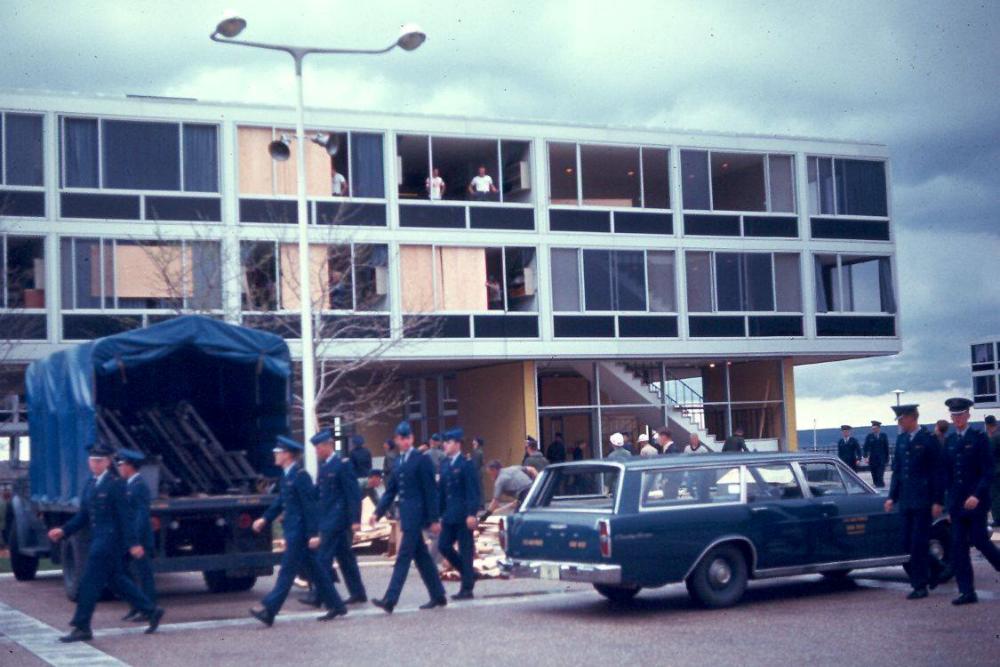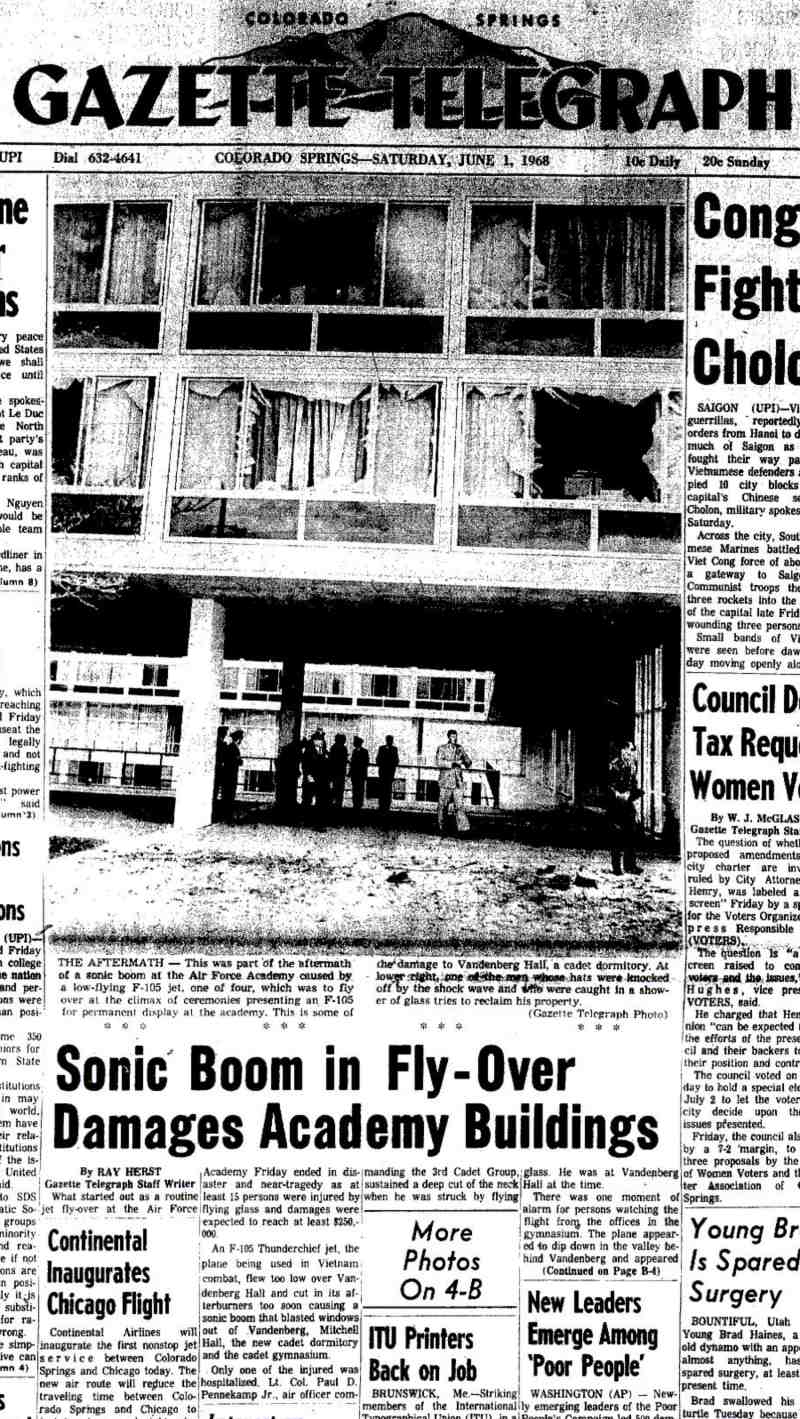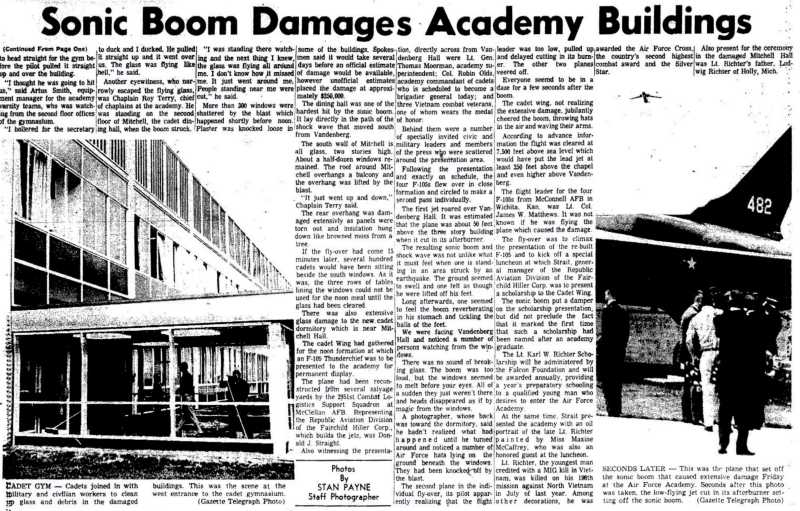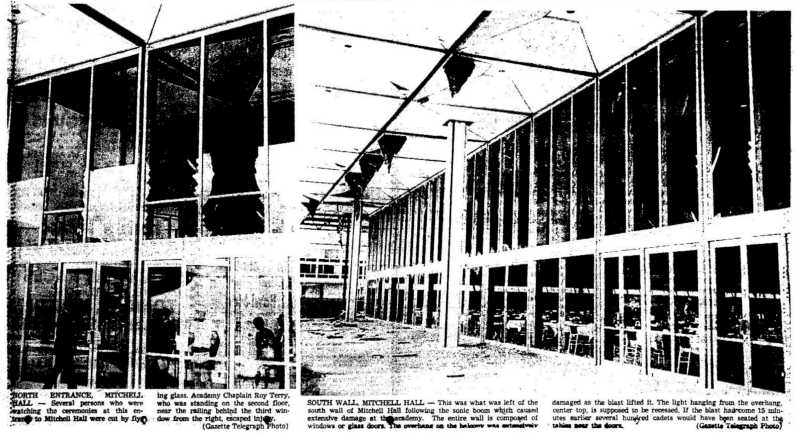|
With a Loud KABOOM, an F-105 Upstaged Our Air Force
Graduation
No one from the Cadet Class of 1968 will forget the day. The
Mach 2, 25-ton F-105 could create an enormous sonic boom. During the
Vietnam War, the fighter-bomber flew dangerous missions and suffered
heavy losses. (USAF)
By Darrel Whitcomb Air & Space Magazine December 2019
In May 1968, the Vietnam War was at its peak. Our nation’s newest
service school, the Air Force Academy, where I was completing my third
year of study, was only 14 years old at the time but already had many
graduates in combat. To honor the Academy, the United States Air Force
sent a decommissioned Republic F-105 Thunderchief—a “Thud,”
in USAF language—to be placed on permanent display. A dedication
ceremony was scheduled for May 31—the first day of graduation-week
festivities for the class of 1968. The academy’s superintendent,
(then) Lieutenant General Thomas S. Moorman Jr. would speak, as would
Major General George Simler, a former F-105 wing commander, and Donald
Strait, an executive with Republic Aviation, which built the F-105.
After their remarks, four Thuds from McConnell Air Force Base in Kansas
would perform a fly-by. We occasionally saw individual aircraft fly
over, but a formation flight would be a rare thing to witness.
When the appointed day arrived, the assembly crackled with anticipation.
We were too busy craning our necks to see the Thuds to pay much attention
to the speakers. The Master of Ceremonies got our attention, though,
when he told us the flight was being led by Lieutenant Colonel James
“Black Matt” Matthews, a veteran of dozens of F-105 combat
missions.
We soon spotted the flight of four F-105s in a holding pattern off to
the east. Then we saw them turn toward us and take up a diamond formation.
We heard their J75 turbojets scream as they flew northward over Mitchell
Hall, the air gardens, and Vandenberg Hall.
The F-105 is a beast of an aircraft, a fighter-bomber built for low
altitude, high-speed operations. The four Thuds streaked by at what
must have been 500 miles per hour. I’ve never forgotten the whistling
sound that announced their passing. Though we were in formation, many
cadets yelled and whistled at the passing jets, a breach of discipline
our superiors were kind enough to overlook.
We expected the formation to recede into the eastern horizon, back to
Kansas. But instead they turned south and took up trail spacing. They
were lining up to make individual passes!
I could clearly see the lead aircraft turn north. This time though,
I could not hear its engine. I noticed a weird quality of light in the
air around the Thud. I didn’t know what that meant, but a cadet
in the next rank, an aeronautical engineering major, obviously did.
I heard him mutter “Oh, shit,” as he clapped his hands over
his ears.
The lead aircraft silently streaked by. Then the air around us seemed
to shimmer, and we heard and felt the KABOOOOOM as the shock wave swept
over us. The F-105 had broken the sound barrier just before passing
over our heads.
As the shock wore off, a few cadets began to clap and cheer, but that
festive sound was quickly silenced by the Ka-pow! Ka-pow! Ka-pow! ?of
windows shattering in Vandenberg Hall.General Moorman was purple with
rage. The commandant, Brigadier General Robin Olds, was apoplectic.
Only when we heard them summoning ambulances did we realize people had
been seriously injured by the flying glass.
My squadron was ordered into the dining hall, the south wall of which
was floor-to-ceiling glass. Or rather it had been, moments earlier.
Everything—the floor, the tables, the plates, and yes, the food—was
now covered with broken glass. We would not be having lunch that afternoon.
We later learned that 15 people had been cut by flying glass. One officer
was hospitalized for several weeks.
Matthews was grounded and his aircraft inspected for defects. A board
of inquiry determined that many were to blame for the incident. While
they found no problem with Matthews’ F-105, rumors persisted that
its airspeed indicator system had a “glitch” that improperly
indicated the true airspeed as it approached the speed of sound. Matthews
had broken numerous regulations, but his flight status was soon restored.
The Vietnam War consumed F-105 pilots very quickly, and he was needed
to train replacements.
News coverage of the incident was mostly unflattering
to the Academy and the service. Fair enough. Nothing could justify so
needlessly dangerous a stunt. But that demonstration of raw power made
a deep and lasting impression on many of us young cadets. At a time
when our nation was at war, it clearly reminded us of our purpose: We
were training to be warriors, just like Jim Matthews.
One of my classmates, Scott Sonnenberg, wrote of the
fly-by years later: “In one split second, a 30-year Air Force career
was born. I don’t know how many other cadets were similarly affected,
but all those windows broken may have been one of the best investments
the Air Force has made in recruitment and retention.”I believe
most cadets from the classes of 1968 to 1971 who witnessed that event
would agree. Many of us went on to serve in the war and in Air Force
careers; 31 of the cadets who watched those Thuds would die in the Vietnam
conflict. Their names are chiseled on the Vietnam Veterans Memorial,
along with 121 other Air Force Academy graduates and 58,000 of our countrymen.
For the rest of us, that fly-by lives on in our memories and in Academy
lore. It was a day we will never forget.
This story is a selection from the December/January issue of Air &
Space magazine.
The person who wrote that article Darrel Whitcomb was a Cs07 1969 class
member. Great guy and great story.
Pat, et al,
I was marching to lunch on Wing Staff right behind our Wing Commander,
Carl McPherson, on that fateful day.
We were approaching Mitchell Hall, and I could see, but not hear, that
F-105, coming very fast and very low from the south.
I had been to air shows where breaking the sound barrier
at altitude and creating a faintly heard sonic boom for the crowd to
hear were the highlights of the shows, so I knew what was coming. I
muttered "Oh sugar!" or something to that effect.
After the boom, waiters came running out of Mitchell Hall waiving their
hands and yelling. The glass also came raining down from the second
floor windows across from the Eagle and Fledgling statue.
I've always been amazed by Carl's presence of mind as
he turned around while marching and ordered "Wing halt." I
don't think this had ever been done before, and I don't think it has
ever been done since.
I was the Wing Logistics Officer responsible for beans and bullets,
so he told me to "Go in there and find out what just happened to
Mitchell Hall."
That made me the first person going into the dining
hall. When I got in there, I saw ceiling panels and insulation hanging
down, and three or four rows of tables in the south end covered with
glass shards. The entire south wall had only three of those very tall
windows still intact.
We told each squadron to sit where they could, eat quickly and not to
touch the peanut butter and jelly, because we had squadrons behind them
that also needed to eat. As far as I know, everyone got to eat something
for lunch that day. Robin Olds' biography talks about this episode and
says that some cadets missed lunch. I don't think so, but please correct
me if I'm wrong.
A couple days later, they announced that they were doing a structural
analysis of the roof on Mitchell Hall to ensure it's integrity. It made
me think of what a large, unsupported structure it is and what a disaster
it would have been if it would have come down on the entire cadet wing.
Let's hear it for the designers and construction crew that built it.
We had the Athletic Awards Banquet in there that night. All of the blown
out windows had been covered with plywood. I don't know where that much
plywood come from, but it worked.
I tell our cadets that it cut a swath of broken windows through Mitchell
Hall, Vandenberg Hall and the Cadet Gymnasium. And, it was the most
motivational thing I saw in my four years there. Air Power!
Thanks,
Carl Janssen, USAFA 68
All:
A diversion from COVID-19 news - my remembrances of that noon meal formation.
It was an interesting beginning of our first day of June Week in 1968...when
that F-105 flew over the noon meal formation....and what flying right
at the speed of sound, at a very low height, could do.
I was in the front of 7th squadron (not the squadron commander, but
in the front row.) I watched the Thud go over the hospital, then drop
out of sight, then, with no sound as I re-call, rip over the top of
Mitch’s. We were closest to the flag pole over which the Thud then
flew..... then the sound and blowing out all the windows I could see
on Vandenberg Hall. I didn’t realize glass was that elastic as
the windows went in about 10 inches, then blew out.
As the first Thud went by, the top of the flag pole was blocked from
my view of that first 105. It was between our squadron and the flag
pole by the air gardens about 80-90 feet away I’d guess. The other
planes that were right behind in trail were going equally fast and low.
I vividly remember the whole Wing broke out into cheers and yelling
and screaming. But then I saw several of the people standing below the
windows of Vandenberg were hurt from the falling glass. We then gaggled
on to Mitch’s and did have some food like Carl said.
After lunch I saw all the damaged windshields of cars along the North
Road, and the glass blown out down at the gymnasium...all quite a sight.
My parents and brother showed up that afternoon, and I remember all
the plywood in Mitch’s and Vandenberg - I didn’t realize there
was that much plywood in the Springs or Denver as we went forward with
all graduation activities the rest of the week with lots of plywood
covering all windows by the next day.
An amazing start for my AF career.
Doug Wilson
USAFA ’68
Guys,
Standing way back toward Arnold Hall in the 22nd SQ formation at the
opposite end of the Wing from Carl, I got the long view.
The shock wave wrapping around that #1 F-105 as it pitched over Mitch's
roof was beautiful--and complete--except for the part that kind of blended
into the building....
And perfectly quiet out west where we stood....
Even after the required Physics classes, I'd never imagined that big
picture windows (looking at many hundreds down the length of Vandy)
were actually flexible enough to vibrate in and out before breaking--some
to the inside and some to the outside.
Watched 'em fall out or disappear inside.
But here's a story you haven't heard: my Mom was a hippie long before
people knew what a hippy was. However, she was married to a senior AF
officer, so unfortunately she got away with a lot.
That morning, she'd driven her big Chrysler Town & Country station
wagon up the ramp (yes...) and parked it near the Superintendent's and
other official vehicles between the ramp and the Vandy Command Post.
When big #1 blasted immediately overhead, she said it was as if the
Jolly Green Giant had just slapped his palm on the top of her now-bouncing
car. She said the windshield of the car next to her was blown into the
driver's lap.
"Mom, you did what?!!!"
"Oh, they were very nice, and asked if I was OK." Now that
I'm 74 years old, I can share this story....
Bill Eckert
|




